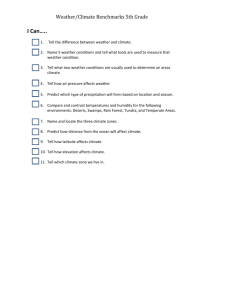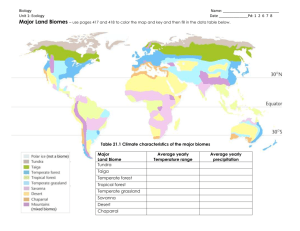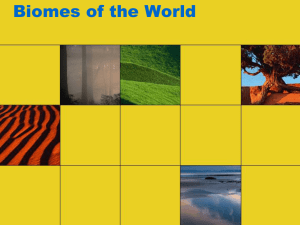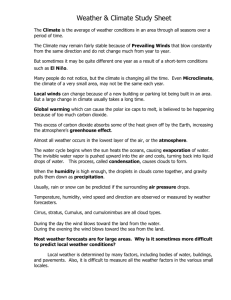lecture_2notes
advertisement
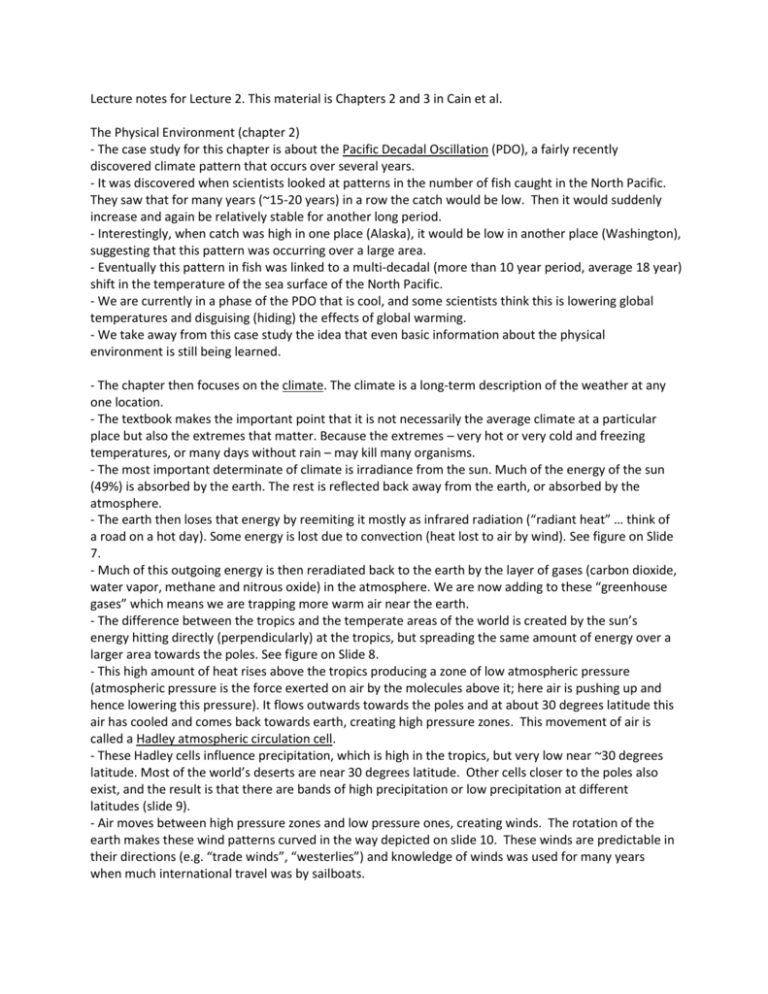
Lecture notes for Lecture 2. This material is Chapters 2 and 3 in Cain et al. The Physical Environment (chapter 2) - The case study for this chapter is about the Pacific Decadal Oscillation (PDO), a fairly recently discovered climate pattern that occurs over several years. - It was discovered when scientists looked at patterns in the number of fish caught in the North Pacific. They saw that for many years (~15-20 years) in a row the catch would be low. Then it would suddenly increase and again be relatively stable for another long period. - Interestingly, when catch was high in one place (Alaska), it would be low in another place (Washington), suggesting that this pattern was occurring over a large area. - Eventually this pattern in fish was linked to a multi-decadal (more than 10 year period, average 18 year) shift in the temperature of the sea surface of the North Pacific. - We are currently in a phase of the PDO that is cool, and some scientists think this is lowering global temperatures and disguising (hiding) the effects of global warming. - We take away from this case study the idea that even basic information about the physical environment is still being learned. - The chapter then focuses on the climate. The climate is a long-term description of the weather at any one location. - The textbook makes the important point that it is not necessarily the average climate at a particular place but also the extremes that matter. Because the extremes – very hot or very cold and freezing temperatures, or many days without rain – may kill many organisms. - The most important determinate of climate is irradiance from the sun. Much of the energy of the sun (49%) is absorbed by the earth. The rest is reflected back away from the earth, or absorbed by the atmosphere. - The earth then loses that energy by reemiting it mostly as infrared radiation (“radiant heat” … think of a road on a hot day). Some energy is lost due to convection (heat lost to air by wind). See figure on Slide 7. - Much of this outgoing energy is then reradiated back to the earth by the layer of gases (carbon dioxide, water vapor, methane and nitrous oxide) in the atmosphere. We are now adding to these “greenhouse gases” which means we are trapping more warm air near the earth. - The difference between the tropics and the temperate areas of the world is created by the sun’s energy hitting directly (perpendicularly) at the tropics, but spreading the same amount of energy over a larger area towards the poles. See figure on Slide 8. - This high amount of heat rises above the tropics producing a zone of low atmospheric pressure (atmospheric pressure is the force exerted on air by the molecules above it; here air is pushing up and hence lowering this pressure). It flows outwards towards the poles and at about 30 degrees latitude this air has cooled and comes back towards earth, creating high pressure zones. This movement of air is called a Hadley atmospheric circulation cell. - These Hadley cells influence precipitation, which is high in the tropics, but very low near ~30 degrees latitude. Most of the world’s deserts are near 30 degrees latitude. Other cells closer to the poles also exist, and the result is that there are bands of high precipitation or low precipitation at different latitudes (slide 9). - Air moves between high pressure zones and low pressure ones, creating winds. The rotation of the earth makes these wind patterns curved in the way depicted on slide 10. These winds are predictable in their directions (e.g. “trade winds”, “westerlies”) and knowledge of winds was used for many years when much international travel was by sailboats. - Winds in turn drive ocean currents. Ocean currents are particularly important because they bring warm or cold water a long distance and hence warm or cool the landmasses they are near. For example, the Gulf Current that runs along North America’s Atlantic coast and goes north, eventually ending in Northern Europe, brings warm climates to high latitude areas like England. Whereas a cool current runs south on the Pacific coast, bringing cold waters from Alaska and making cities at low latitudes like San Diego relatively cool. - In some places the prevailing winds run parallel to the coast, and this sort of circulation drives water from the bottom of the ocean upwards, called an “upwelling”. Because nutrients accumulate in deep ocean waters (falling from above), upwelling brings nutrient-rich water to the surface and provides a rich environment for life. Some of the world’s greatest fishing areas are in regions of upwelling. - So climate is influenced by latitude and ocean climates. It is also influenced by elevation. Remember that infrared radiation is coming from the ground, so at higher distances from the ground there is less energy. Air near mountains mixes directly with this cold air, and also as one gets further from the earth the air has fewer gas molecules that can absorb heat. These are reasons why temperature declines as elevation increases. - There are also regional influences on climate produced by the positions of mountains, or the distance to the ocean. Water retains heat well and stabilizes temperatures so that day and night temperatures are relatively close together near the ocean, whereas areas in the interior of continents can get very cold at night and very hot during the day. Mountains block clouds, meaning that rain all falls to one side of them and the other side is very dry (the mountain’s “rain-shadow”). - The vegetation at a particular place also influences the weather. Summarizing a rather complex figure on slide 16, we see forest (dark in color) absorbs more heat, and reflects back less, than grassland (light in color), keeping those areas warmer. But this effect is outweighed by the fact that forest has a lot of heat lost due to evaporation from plants (known as evapotranspiration; this also creates clouds that then precipitate). Hence, deforestation -- the loss of forest -- creates a warmer, drier climate. - We then turn to what controls the variation in the climate over time. First we discuss seasonal variation. The earth is tilted on its rotation so that irradiance at high latitudes changes seasonally because the sun is either directly shining on it, or away from it. See Figure on page 17, and convince yourself that this occurs by using a ball as a model of earth and moving it around a flashlight. During the summer the sun never sets at the poles. - As said before, water retains heat better than land, and it does not get as cold during the winter as the land does. Water is stratified, with warm layers of water (nearer the sun) sitting above cold layers. In a lake, for example, the cold deep part of the waters will not circulate with the top parts during the summer. Dead organisms will sink into this lower layer of water making it resource rich. In the fall the surface water will become less warm and will begin to sink, mixing the surface and lower waters. This “turnover” event is important because the nutrients trapped in the bottom of the lake in the summer are redistributed throughout the lake. - Beyond seasonal variation, climate also changes over several years. The best known example of this is the El Niño oscillation. El Niño occurs every three to six years and alternates with La Niño, which has the opposite characteristics. The high pressure cells change in their location in the south Pacific, west of South America. This disrupts the normal trade winds and increases surface temperatures of the ocean and decreases upwelling. The most apparent symptom of El Niño is poor fish numbers from the lack of upwelling, but other effects are seen as far away as Indonesia, where fires may be more frequent and mass-fruiting trees may use the weather changes as a cue to start flowering. PDO is another oscillation that we don’t understand as well as El Niño. - And finally there is the long-scale of time variation. For example in the 10,000 year scale, temperatures go up and down leading to glaciation events. The most recent glacial maximum was 18,000 years ago. And then in the millions of years there have been regular oscillations in temperature. See Slide 21. - What causes these long time-scale variations in climate? As we talked about earlier, earth’s axis is tilted, and the angle of this tilt changes between 24.5 degrees and 22 degrees every 41,000 years. Over a period of 100,000 years earth’s axis changes in shape from elliptical to more circular. And Earth’s orientation relative to other celestrial bodies (e.g. stars) also changes. All of these changes, collectively known as Milankovitch cycles after the scientist who discovered them, probably produce the oscillations in climate that we’ve discussed. - Factors other than climate also influence life on earth. We discuss three briefly: salinity, acidity and oxygen. - Water varies highly in the amount of solute, particularly salt, dissolved in it. Most freshwater has very little salt, but some lakes without outlets (e.g. Dead Sea, Great Salt Lake) accumulate salt that enters from dissolving out of rock and concentrates due to evaporation. Salinity is also a big problem for farming as it kills plants. Areas that are at risk for salinity include areas near the sea and also hot regions where irrigation is used a lot. Irrigation sometimes is pumped up from underground water reserves, bringing with it salts, and high evaporation rates concentrate the salt in soils. - Acidity is measured by pH, a log scale that measures how many H+ ions are present in the water, with a neutral rating of 0 (distilled water), acidic readings below this and base readings above this. pH is very important to living organisms as must organism’s enzymes only work under a limited range of pH. The pH of freshwater can vary quite strongly; in contrast the huge amounts of water in the oceans mean that it is quite constant there. However, there is concern that CO2, building up due to human emissions, could change the acidity of the oceans: CO2 makes water acidic (think of a carbonated beverage). Corals are known to be very sensitive to acidity of the oceans, and these changes in CO2 levels may be related to mass die offs of corals known as coral bleaching. - Oxygen doesn’t vary much today in the atmosphere, but did historically. In the ancient earth, oxygen was very rare… it built up over billions of years due to the activity of plants. Today there are a few ecosystems like deep sea trenches or soil in peat bogs that are low in oxygen and special organisms that thrive in anoxic conditions are plentiful there. Chapter 3 of the textbook concentrates on the different biomes found on earth. - The book defines a biome as a “large-scale biological community shaped by the physical environment”. - The basic terrestrial (land-based) biomes the book describes have different combinations of temperature and precipitation. See figure on Slide 28. - Biomes are characterized by the dominant life forms of plants (for example, broad leaf deciduous trees; or grasses and sedges). This is because plants can’t move (as adult individuals) and are therefore particularly sensitive to climate. - Note the climate diagrams on the biome slides and what information they give (principally temperature and precipitation). - We then toured the primary terrestrial biomes: - Tropical rainforests. High temperatures and a lot of precipitation all year round. Huge diversity: perhaps 50% of earth’s species in 11% of terrestrial vegetation cover. Poor soils because of high decomposition. Threatened by logging and deforestation. - Topical seasonal forests. High temperature; seasonal precipitation. Characterized by deciduous trees, open forests, often with regular fires. One of the most threatened biomes because of heavy population pressure in these areas. - Deserts. Hot and little precipitation. Often in the 30 degree N and S latitude. May bloom for short wet periods. Deserts may expand in areas where humans have overused (unsustainable grazing by livestock). - Temperate grasslands. Warm moist summers and cold dry winters. Grassland may be maintained by fires of grazing animals. Threatened because of usefulness of areas for agriculture. - Temperate shrublands and woodlands. Cool wet winter and hot dry summers lead to limited growth of plants. Often called Mediterrean climates, can be highly diverse, and highly threatened because of human population and development. - Temperate deciduous forests. More rainfall than temperate grasslands. Trees lose leaves seasonally. Soild are rich because of leaf loss and lower rates of decomposition. Historically a lot of agriculture, recently beginning to be reforested. - Temperature evergreen forests. Areas of high rainfall and dominated by coniferous trees. Sometimes called temperate rainforests. Threatened by logging and development. - Boreal forests. Generally above 50 degrees latitude where soils freeze in winter. Waterlogged soils because of permafrost (layer of soil frozen continuously)and abundant precipitation. Mostly coniferous forests with low diversity. Historically untouched but recently have begun to be logged. - Tundra. Generally above 65 degrees latitude, where trees can no longer exist because of cold temperatures. Quite dry, blooms in short warm period. - The book stresses that habitats in mountainous areas are quite different from what surrounds them because of the temperature decline as one climbs (1000 m up, - 6.5 C). High alpine zones resemble tundra, and coniferous forests resembling boreal forests are found at somewhat lower elevations. Hence there are dramatic changes in vegetation in relatively short distances. - There are also aquatic biomes, which the book summarizes quickly. - Freshwater systems consist of rivers and streams and lakes. - Rivers and streams are classified by how close they are to the headwaters (where they start). Large differences are seen due to the speed of the water movement (greater speed gives more dissolved oxygen in the water). Rivers have been dramatically disturbed by humans through pollution and damming. - In lakes, large differences are seen between the area near the surfaces, where most life exists, and the lower layers, generally with little light penetration or light, and the bottom substrate. They are threatened by pollution and irrigation, which subverts their water. - Oceanic systems can be divided into three zones: near-shore, shallow oceans, and pelagic areas. - Of near-shore biomes, some of the most familiar include mangroves (generally found in tropical areas), and saltwater marches (generally found in temperate areas). These areas as well as estuaries (where freshwater meets saltwater) can be highly productive, as measured by the amount of biomass produced per year. - The shore area itself is characterized by tidal changes, driven by the gravitational forces between the Earth, the moon and the sun. Rocky intertidal zones show very distinct communities depending on whether they are relative to the tidal maximum and minimum. Sandy shores are less biodiverse as there is little for organisms to hold onto. - In shallow seas the primary biomes are coral reefs (most often found in the tropics) and kelp or seagrass beds (mostly temperate). Coral reefs are the rainforests of the seas, with immense biodiversity. They are highly threatened by overharvesting and climate change. Kelp beds are also very productive in terms of their biomass. - The open oceans (pelagic biome) has a thin layer of life between 0 and 200 m where light penetrates. Photosynthetic plankton near the surface are the foundation of the oceanic food chain. The bottom of the oceans would seem a very harsh environment with low temperatures and high pressures, but we are finding through the use of submersibles more biodiversity there than we expected.


